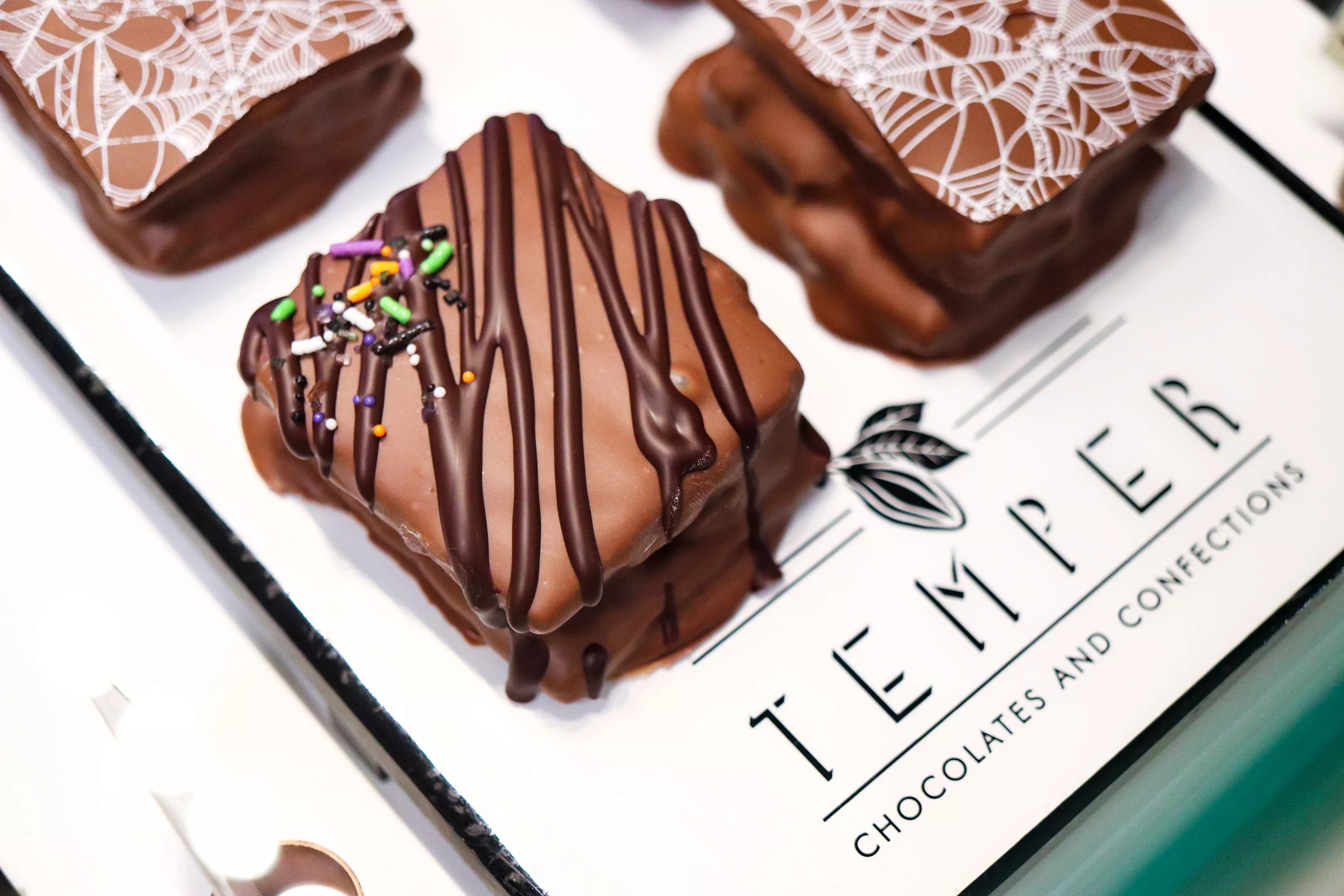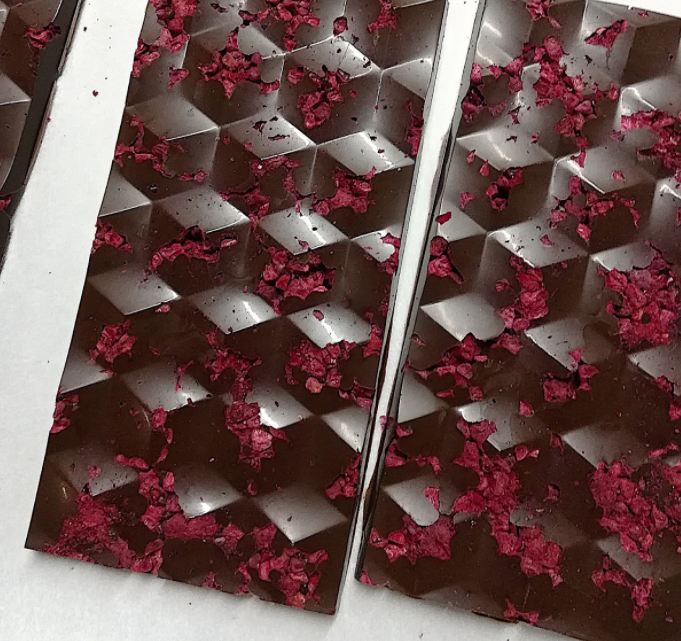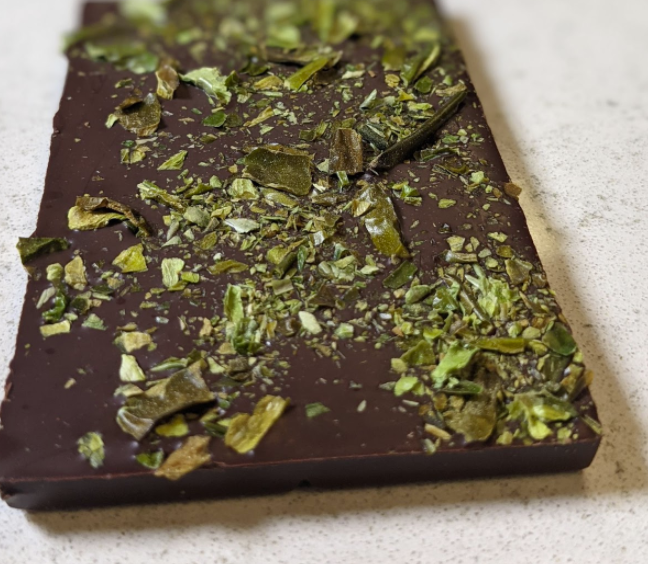
Michael Kimball

Audio By Carbonatix
You might be thinking, “Is there a wrong way to eat chocolate?” Seems unlikely, but when it comes to chocolate, we don’t want to take any chances. Especially with Halloween just around the corner. Thankfully, Denver is home to more than a few chocolate experts (aka chocolatiers) that have mastered the art of chocolate tasting and can help answer this and other very important questions. Like, what does it mean to conch chocolate, and does it involve seashells?
But before the tasting begins, you’ll need to choose your chocolate. Deciding between dark, milk and white is just the beginning. The type and origin of the cacao beans, the percentage of cocoa solids and inclusions like fruits or caramel can all drastically affect the character of the chocolate.
Jenny Bazzetta, experienced chocolatier and co-founder of Colorado Springs-based Bonbon Bombardier, recommends comparing a single variety for a tasting, such as bittersweet chocolates in the 70% range, “to best perceive the subtle differences in flavor that can exist in a type of chocolate. Chocolate tasting can be as complex, challenging and fun as you want to make it.” Whether you focus on chocolate from specific regions of the world or the way that different inclusions enhance a chocolate’s key flavor notes, there’s always something new and exciting to explore.
Chocolate tasting should involve all five or your senses, and these techniques can help elevate the experience from a simple sugar rush to a true culinary adventure.
Denver, make your New Year’s Resolution Count!
We’re $15,500 away from our End-of-Year campaign goal, with just a few days left! We’re ready to deliver — but we need the resources to do it right. If Westword matters to you, please contribute today to help us expand our current events coverage when it’s needed most.

The PBR Bar is made with 55% dark chocolate, natural peanut butter, tart raspberries and sea salt.
Bonbon Bombardier
Sight The award-winning Blueberry Crunch Bar from Coco Gusto is made with semisweet chocolate and sprinkled with blueberries and cocoa nibs. Michael Kimball
You can tell a lot about a chocolate before you ever put it in your mouth. The color and overall appearance can be indicative of its quality and characteristics. One look at the handsomely hand-painted chocolates from founder Wade Stembridge’s Denver-based Coco Gusto, and it’s clear that he understands the importance of eating with your eyes first. He explains that a good-quality chocolate “will have a glossy, smooth and even finish.” This is evidence that the chocolate was properly tempered, a temperamental process of heating and cooling chocolate at precise temperatures to ensure proper crystallization. 
Sound
Another way to check that your chocolate has been tempered correctly is to listen to it. Break off a piece and listen for a “good, brisk snap,” says Sarah Chesnutt from Boulder’s Moksha Chocolate. This again indicates that “the molecules are aligned correctly” for the best texture and that melt-in-your mouth quality. Chesnutt adds that the snap is also telling of the fat content, with higher-fat chocolates producing a “more gentle snap.”

The Colorado Pueblo Chile Bar contains hand-roasted Pueblo chiles from Mauro Farms.
Moksha Chocolate
Smell The Alpine Dark Chocolate Bar is infused with hand-picked ponderosa pine needles to give it the fresh aroma of our Colorado mountains. Miette et Chocolat
Next, rub the chocolate with your thumb to slightly melt the surface and release its aromas. What do you smell? Red fruits? Honey? Butterscotch? Gonzo Jimenez is a real-life Willy Wonka (if Willy Wonka were from Argentina and didn’t turn children into blueberries), star of Netflix’s Bake Squad and co-owner of Miette et Chocolat, which has locations inside Stanley Marketplace and in Aurora. Jimenez compares this step to swirling and sniffing wine before you take your first sip. “There is no right or wrong to what we smell or taste,” he says. “We can all sense different notes and aromas, and that’s okay.”
Touch
Now it’s time to (finally) eat the chocolate. Place it on your tongue and let it start to melt without chewing. Jimenez tells us to look for a chocolate that “melts in your mouth easily and feels very smooth between your palate and your tongue.” These pleasant qualities come in part from the conching process, where the chocolate is mixed, sheared and aerated anywhere from six to more than ninety hours to achieve uniform particle size and cocoa butter distribution. And while conching may not involve seashells, it did get its name from the shape of the traditional machinery, which resembles a conch shell.

These painted bonbons are inspired by the works of Van Gogh.
Temper Chocolates & Confections
Taste
As the chocolate melts in your mouth, it’s time to put your tastebuds to work. Chocolatier Victoria Johnson of Temper Chocolates & Confections inside Denver Central Market advises that you prepare for a flavor journey. “Observe how the flavor changes,” she says. “A strong flavor may come through quickly, while on the other hand, it may build up and intensify over time.” Be sure to keep some room-temperature water nearby to use as a palate cleanser, and also something to take notes on. Notes can help you home in on what you’re experiencing and be better able to share it with your fellow chocolate-tasting compatriots.
The next time you’re about to treat yourself to some choice chocolate, we hope you give these tips a try. Fingers crossed that all of our neighbors are handing out local, hand-painted, single-origin, bean-to-bar, pine-infused chocolate on Halloween.
And if not, now you know where to find it.